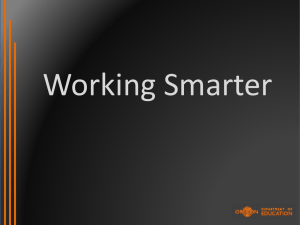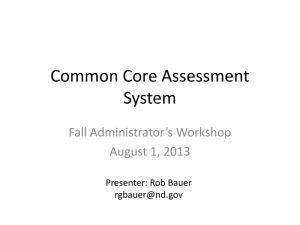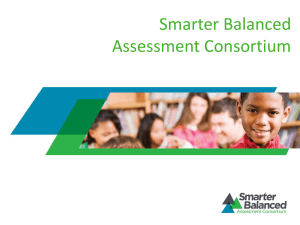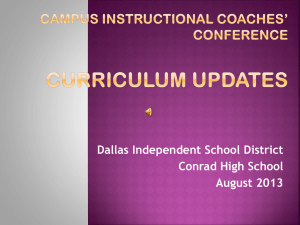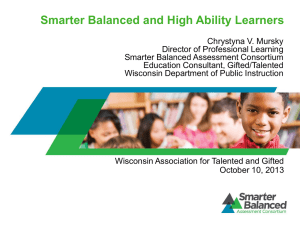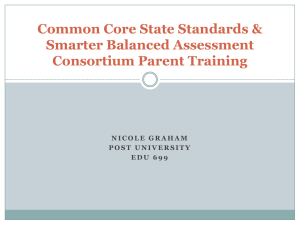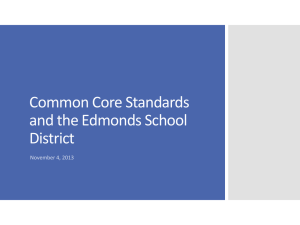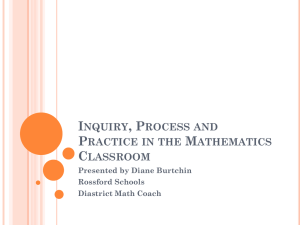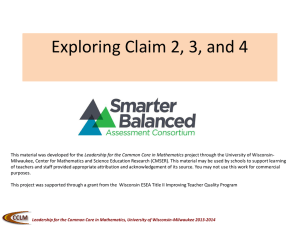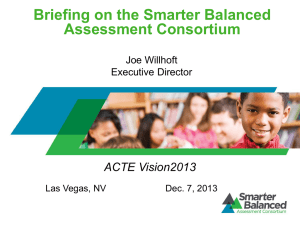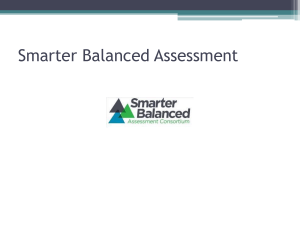Smarter Balanced Mathematics
advertisement
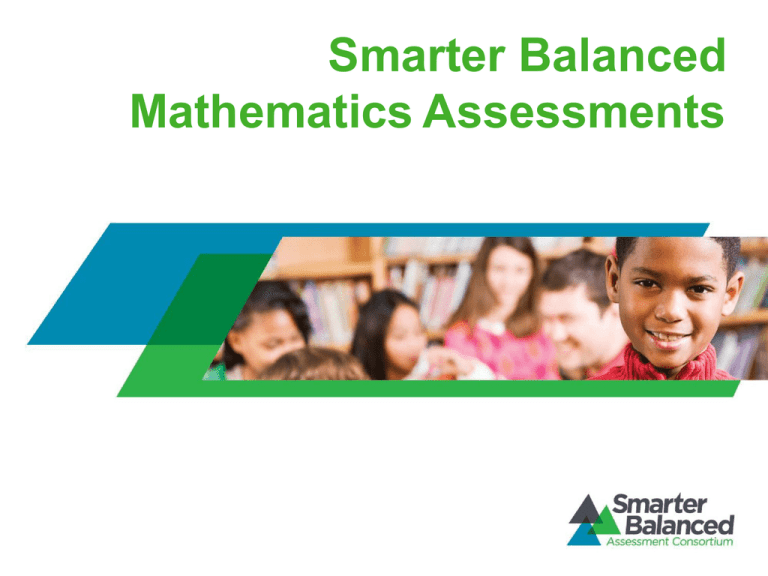
Smarter Balanced
Mathematics Assessments
Agenda
•
•
•
•
Understanding the Content of the Grade 11 Summative
Mathematics Assessment
Exploring Innovative Ways to Use Technology to
Measure, Capture, & Score Mathematical Reasoning
Updates on Mathematics Performance Tasks
DRAFT Calculator Policy
Understanding the Smarter Balanced
Grade 11 Summative Mathematics Assessment
Mathematics Claims
Claim #1 - Concepts &
Procedures
“Students can explain and apply mathematical concepts and
interpret and carry out mathematical procedures with precision and
fluency.”
Claim #2 - Problem Solving
“Students can solve a range of complex well-posed problems in pure
and applied mathematics, making productive use of knowledge and
problem solving strategies.”
Claim #3 - Communicating
Reasoning
“Students can clearly and precisely construct viable arguments to
support their own reasoning and to critique the reasoning of others.”
Claim #4 - Modeling and Data
Analysis
“Students can analyze complex, real-world scenarios and can
construct and use mathematical models to interpret and solve
problems.”
Overall Claim for Grades 3-8
“Students can demonstrate progress toward college and career
readiness in mathematics.”
Overall Claim for Grade 11
“Students can demonstrate college and career readiness in
mathematics.”
Why should the grade 11 assessment
draw on content from earlier than grade 9?
CSSM, p. 84:
“…some of the highest priority content for college and
career readiness comes from Grades 6-8. This body of
material includes powerfully useful proficiencies such as
applying ratio reasoning in real-world and mathematical
problems, computing fluently with positive and negative
fractions and decimals, and solving real-world and
mathematical problems involving angle measure, area,
surface area, and volume.”
Source: Common Core State Standards for Mathematics
Alignment of the Smarter Balanced
Summative Content Specifications
•
“Tasks generating evidence for Claim #2 in a given
grade will draw upon knowledge and skills articulated
in the progression of standards up through that grade,
though more complex problem-solving tasks may draw
upon knowledge and skills from lower grade levels.”
Source: Content Specifications for the summative assessment of
the Common Core State Standards for Mathematics
How has Smarter Balanced used the research and
the information in the Publisher’s Criteria?
•
•
Claim 1 (Concepts and Procedures) has 16 targets in
high school, which correspond to 16 CCSS-M
clusters with relatively high importance for College &
Career.
High school standards that do not appear as a
separate target in Claim 1 or on the lists for Claims 2,
3, & 4 (in the following slides) will NOT be measured
on the grade 11 summative assessment.
Claim #2: Students can solve a range of complex well-posed
problems in pure and applied mathematics, making productive
use of knowledge and problem solving strategies.
Claim #3: Students can clearly and precisely construct viable arguments
to support their own reasoning and to critique the reasoning of others.
Claim #4 - Students can analyze complex, real-world scenarios
and can construct and use mathematical models to interpret
and solve problems.
Rationale for not measuring every
standard on the grade 11 summative
•
•
•
Content identified for the assessment is based on
research related to prerequisite skills for collegeand- career readiness
Allow states to make good decisions about how to
structure the content across high school, including
options that spread the standards across four years
instead of three
Example of content not measured on Grade 11
summative
– G.C.A Understand and apply theorems about circles
• G.C.A.1 Prove that all circles are similar.
Pushing the Limits on
Measuring Mathematical
Reasoning in Assessment
Why is capturing students’ reasoning so
important?
“On the CMT [Connecticut Mastery Test], I work and
work and work on a problem. Then I go to fill in my
answer and it’s not there. But this test [Smarter
Balanced pilot] let me tell how I solved it.”
-- Grade 3 student from Wethersfield, CT, when asked by
the district math coordinator to give feedback on the
Smarter Balanced math pilot
But capturing and scoring
students’ mathematical
reasoning via technology
is easier said than done.
Ch loe is responsm le for making 32 centerpieces for the tables at this year 's :&ehoo·l prom She v.riU
place 8-inch tall cylindiica] cand es into pr -m v c s of the same height. Then she wi11 fill the
space between the candles and the vases halfwary with biuc sand.
candle
4 .5 in.
vase
8.0 in.
•'
..
··-·-··--.... -..
.·-
5 .0 in .
Sand ·is so!ld in 240 cubic ·inch ba at $4.79 per bag. How·much Wil l Chloe spend on the sand to
create 32 centerpieces? Show ·your w ork or explain 'how yon found ) 'Ou r answer.
cl' '
%
o...Y't\
G.f.;c - Q) S '
v-o W \ W
of
l t h u it <-C....VV'J
ot>i'- +o
? 'e
'"'
e<A.(...
-
f u n 1: M
ho'v Calculation
\0 0 -
o
lD"'?,. CD
l.P • Y'A ' l S,J o."'
VOL
( l d ..<:,
\\c..4 _.}.' - \
')...'-\( )
::7
s\
'-\ .. '15
'
Smarter
Balanced
Assessment Consortium
Attempts to “Capture” Student Work often
Eliminate the Autonomous Reasoning Called
for in the Content Specifications
Imagine the same problem was posed as a
series of questions in an attempt to “capture”
reasoning:
•
•
•
•
•
•
What is the volume of ½ the candle?
What is the volume of ½ the vase?
How much sand in each vase?
How many sand for all vases?
How many bags of sand?
How much would that cost?
Other System Limitations
•
F.IF.C.7 Graph functions expressed symbolically and show key features of
the graph, by hand in simple cases and using technology for more
complicated cases.
a.Graph linear and quadratic functions and show intercepts, maxima, and
minima.
b.Graph square root, cube root, and piecewise-defined functions,
including step functions and absolute value functions.
c.Graph polynomial functions, identifying zeros when suitable
factorizations are available, and showing end behavior.
d.(+) Graph rational functions, identifying zeros and asymptotes when
suitable factorizations are available, and showing end behavior.
e.Graph exponential and logarithmic functions, showing intercepts and
end behavior, and trigonometric functions, showing period, midline, and
amplitude.
0
u a n d Te l le r h a d a t
nt that
t -by - I 0 f e e .
is 8
3-fe t b y 6 c h a d u l t h s sl
p1ng b a g hat
feet.
t fa
dults wout
f i t an h e
n t.
ach a
a . 10s r u s i d h
u
l
t
I 8
18 n
e d s 1 8u s q u
8
e t o f f lo o r
. 8
q au cr f
t, s o
72.
h t n i s r e8 0 ss p
o o m to sp
T ller said
that
it i n
h t r i e d a nt hd
coul
n o r g ei st froe u. r a d u l t s
to
ent C.
b.
...1.Smarter
Gavin, M. K., Cas
Measuring with the
opley, J. II., & Sheffield, L. J. {2008}. Project M2: Using Everyday Measures:
e-IIMIIfiJI'!o
!:m Project M2: Mentoring Young Mathematicians series.
s! l ! £
Slide 34
Known Gaps
•
•
•
Some types of graphs and other mathematical models are
difficult to construct in a way that mirrors the kind of student
understanding gained through hand-drawn
Claim 2 Problem Solving
• Known gap of capturing students responses via technology
(graphic images as well as a seamless integration of typewritten
explanations with equations/math symbols)
Claim 3 Communicating Reasoning
• In particular, target B that asks for students to present chains of
autonomous reasoning
• Presentation of content related to reasoning (written text on the
assessment vs. audio/visual in classroom instruction)
Purposes of the Math Reasoning Project
•
•
•
•
•
Enhance the knowledge base regarding authentic evidence of
mathematical reasoning.
Increase the validity of test scores by increasing the breadth of the
Common Core standards that are measurable via computers.
Strengthen educator engagement and ownership of the
assessments.
Enable students to incorporate graphical representations using
natural user interfaces in their response to mathematics items.
Improve the efficiency of the scoring of mathematical reasoning by
use of automated processes.
Immediate Next Steps
•
•
Expert combined mathematics content and technology panel will
meet in early October to define the evidence gap between what we
want to be able to measure and what we are currently able to
measure
Two phase development plan
– Phase 1 development focused on items that we can already
capture, but want to be able to score using technology
– Phase 2 will focus on newer technologies as defined and
prioritized after the panel meeting
Performance Tasks in
Mathematics
Performance Tasks: What did we learn
during pilot?
•
•
•
More hand scoring is needed to measure complex reasoning,
application, and research skills, and rubrics must take into account
the entire task not just individual parts
Early grades performance tasks take too long
Classroom Interaction will be available for all performance tasks in
field test
Sample SBAC Math
Performance Tasks
SBAC Practice Test Portal:
http://sbac.portal.airast.org/practice-test/
Scoring Guides:
http://sbac.portal.airast.org/practicetest/resources/
DRAFT
Calculator
Policy
Calculators on the Smarter Balanced
Math Assessments
Grades 3– 5 Calculator Policy
Smarter Balanced summative mathematics assessments for grades 3–5 do not
allow for calculator usage.
Grades 6– 8 Calculator Policy
• In grades 6–8, the Smarter Balanced summative mathematics assessments are
divided into two sections: Calculator Available and Calculator Not Available.
• The Smarter Balanced summative mathematics assessment for grade 6 allows an
online four-function calculator during the Calculator Available section.
• The Smarter Balanced summative mathematics assessments for grades 7 and 8
allow an online scientific calculator during the Calculator Available section.
High School Calculator Policy
• In high school, the Smarter Balanced summative mathematics assessments are
divided into two sections: Calculator Available and Calculator Not Available.
• The Smarter Balanced summative mathematics assessments for high school allow
online calculators with scientific, regression, and graphing capabilities during the
Calculator Available section.
Find Out More
Smarter Balanced
can be found
online at:
SmarterBalanced.org
